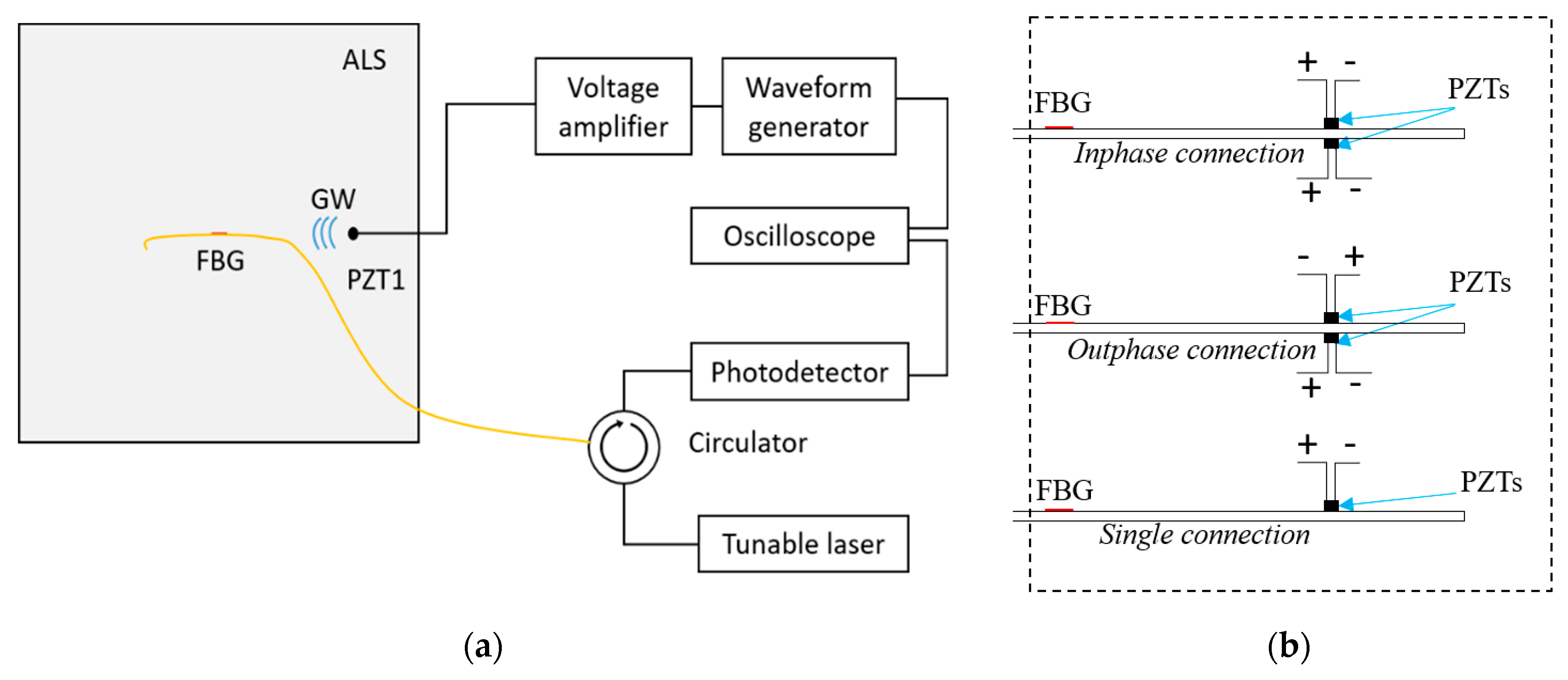Study of Bond Length and Its Effect on Guided Waves Using Fiber Optic Sensors †
Abstract
:1. Introduction
2. Experimental Analysis
3. Results and Discussion
4. Conclusions
- FBG-based remote, direct bonding with different PZT connections was analyzed to understand the bond length and its effects on GW signals.
- It was observed that the GW signals showed changes in the amplitude at the varying length of the adhesive spread.
- The outcomes of using different PZT connections were also supported by the obtained signal plots from the experiments, matching the reasoning.
- The remote bonding studies showed a linear positive increase trend of values while direct bonding shows mostly a decrease.
- Further studies involve performing numerical studies to support the experimental verifications and a mode separation analysis to check other parametric values of other available modes.
Author Contributions
Funding
Data Availability Statement
Acknowledgments
Conflicts of Interest
References
- Soman, R.; Wee, J.; Peters, K. Optical fiber sensors for ultrasonic structural health monitoring: A review. Sensors 2021, 21, 7345. [Google Scholar] [CrossRef] [PubMed]
- Balasubramaniam, K.; Soman, R.; Malinowski, P. Development of GUI Based Tool for the Visualization of the FBG Spectrum Subjected to Guided Waves. In European Workshop on Structural Health Monitoring; Springer International Publishing: Cham, Switzerland, 2023. [Google Scholar]
- Wee, J.; Wells, B.; Hackney, D.; Bradford, P.; Peters, K. Increasing signal amplitude in fiber Bragg grating detection of Lamb waves using remote bonding. Appl. Opt. 2016, 55, 5564–5569. [Google Scholar] [CrossRef] [PubMed]
- Wee, J.; Hackney, D.; Bradford, P.; Peters, K. Experimental study on directionality of ultrasonic wave coupling using surface-bonded fiber Bragg grating sensors. J. Lightwave Technol. 2017, 36, 932–938. [Google Scholar] [CrossRef]
- Huang, H.; Balusu, K. A Theoretical/Numerical Study on Ultrasound Wave Coupling From Structure to Remotely Bonded Fiber Bragg Grating Ultrasound Sensor. J. Nondestruct. Eval. Diagn. Progn. Eng. Syst. 2021, 4, 021007. [Google Scholar] [CrossRef]
- Balasubramaniam, K.; Soman, R.; Malinowski, P. Guided waves based damage detection based on quadrant area using optical fiber sensors. In Health Monitoring of Structural and Biological Systems XVI; SPIE: Bellingham, WA, USA, 2022; Volume 12048, pp. 44–51. [Google Scholar]
- Haider, M.F.; Bhuiyan, M.Y.; Poddar, B.; Lin, B.; Giurgiutiu, V. Analytical and experimental investigation of the interaction of Lamb waves in a stiffened aluminum plate with a horizontal crack at the root of the stiffener. J. Sound Vib. 2018, 431, 212–225. [Google Scholar] [CrossRef]
- Goossens, S.; De Pauw, B.; Geernaert, T.; Salmanpour, M.S.; Khodaei, Z.S.; Karachalios, E.; Saenz-Castillo, D.; Thienpont, H.; Berghmans, F. Aerospace-grade surface mounted optical fibre strain sensor for structural health monitoring on composite structures evaluated against in-flight conditions. Smart Mater. Struct. 2019, 28, 065008. [Google Scholar] [CrossRef]






| S.No | Connection Type | Outcomes | Reason |
|---|---|---|---|
| 1 | Outphase (+,−) | amplifies A0 mode | In-plane S0 mode gets canceled due to negative polarity, and A0 GW mode amplifies. |
| 2 | Inphase (+,+) | amplifies S0 mode | A0 mode is out-of-plane; the out-of-plane motion gets canceled, making S0 mode amplified. |
| 3 | Normal (+,0) | A0, S0 mode | Signal with A0, S0 modes. |
| S.No | Configuration and Connection | Peak Amplitude at H | Peak Amplitude at 4H | Percentage Increase/Decrease |
|---|---|---|---|---|
| 1 | Remote-outphase | 0.4 | 1 | 60% Increase |
| 2 | Remote-inphase | 0.84 | 1 | 16% Increase |
| 3 | Remote-single | 0.82 | 0.95 | 14% Increase |
| 4 | Direct-outphase | 1 | 0.65 | 35% Decrease |
| 5 | Direct-inphase | 1 | 0.45 | 55% Decrease |
| 6 | Direct-single | 1 | 0.7 | 30% Decrease |
Publisher’s Note: MDPI stays neutral with regard to jurisdictional claims in published maps and institutional affiliations. |
© 2022 by the authors. Licensee MDPI, Basel, Switzerland. This article is an open access article distributed under the terms and conditions of the Creative Commons Attribution (CC BY) license (https://creativecommons.org/licenses/by/4.0/).
Share and Cite
Balasubramaniam, K.; Soman, R.; Malinowski, P. Study of Bond Length and Its Effect on Guided Waves Using Fiber Optic Sensors. Phys. Sci. Forum 2022, 4, 8. https://doi.org/10.3390/psf2022004008
Balasubramaniam K, Soman R, Malinowski P. Study of Bond Length and Its Effect on Guided Waves Using Fiber Optic Sensors. Physical Sciences Forum. 2022; 4(1):8. https://doi.org/10.3390/psf2022004008
Chicago/Turabian StyleBalasubramaniam, Kaleeswaran, Rohan Soman, and Paweł Malinowski. 2022. "Study of Bond Length and Its Effect on Guided Waves Using Fiber Optic Sensors" Physical Sciences Forum 4, no. 1: 8. https://doi.org/10.3390/psf2022004008
APA StyleBalasubramaniam, K., Soman, R., & Malinowski, P. (2022). Study of Bond Length and Its Effect on Guided Waves Using Fiber Optic Sensors. Physical Sciences Forum, 4(1), 8. https://doi.org/10.3390/psf2022004008








